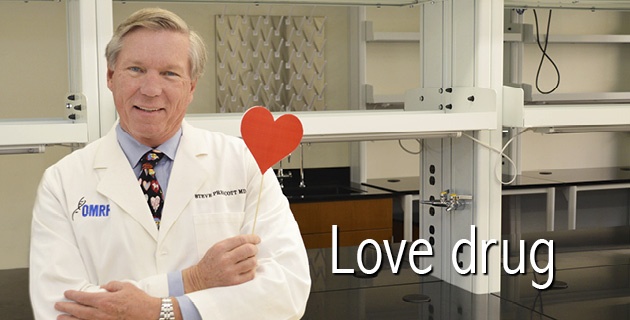 As it turns out, all those pop music lyrics and Hollywood one-liners were right on target: in the human brain, love really does function a lot like a drug.
As it turns out, all those pop music lyrics and Hollywood one-liners were right on target: in the human brain, love really does function a lot like a drug.
So when you’re stocking up on roses, cards and chocolate for your significant other this Valentine’s Day, you’re not just being romantic, said OMRF President Stephen Prescott, M.D. You’re also feeding an addiction.
“When people experience the sensation of falling in love, it’s directed by the pleasure centers in the brain,” said Prescott. “It creates a powerfully good feeling, like everything is right with the world.”
Love itself may be too abstract or intangible for scientists to study thoroughly, but what it looks like is right in their wheelhouse. Neuroscientists have studied people who say they’re in love to see how their brains react to certain stimuli. They have learned that the brain of someone who has fallen in love looks similar to the brain of an addict.
Using scans called functional magnetic resonance imaging, or MRI, researchers at Stanford University observed that feelings of love triggered the same cells that make and receive dopamine, a chemical that stimulates the brain’s pleasure center. Dopamine can bring on a sense of euphoria and is the same chemical in the brain activated in people with addictions to drugs, gambling or overeating.
Rheal Towner, Ph.D., director of OMRF’s Advanced Magnetic Resonance Center, uses MRI to diagnose and predict the outcomes of diseases like brain cancer. While he’s no expert on love, he has spent years observing processes in the brain and said he was fascinated by the results of love studies done at Stanford.
“Functional MRI works by looking at the oxygen you use in your brain,” he said. “When you use oxygen during some sort of biological process, like thinking or moving, the corresponding area of the brain lights up on the monitor.”
To study specific responses, researchers use different stimuli like visual or auditory cues to elicit a reaction in the brain. In the case of the love study, researchers used cues like showing subjects a picture of loved one along with another photo of a stranger as a control to gauge how the reactions in the brain differed.
“You can use functional MRI to do all sorts of things. You can watch what happens when people talk about a specific topic, try to solve a difficult math problem and so on,” said Towner. “When they showed people pictures of their romantic partners or loved ones, the response in the brain was much like that of someone hooked on cocaine.”
Just as addiction to drugs or shopping can impair judgment, so can feelings of love. It might even account for all the couples that decide to elope on Valentine’s Day.
True addiction is a serious condition, said Prescott. “But if you’re going to be addicted to anything,” he said, “love is a great choice.”


